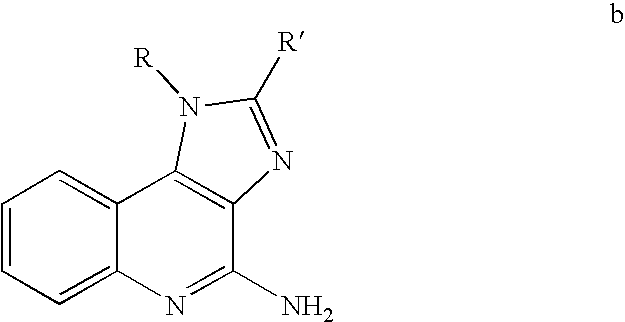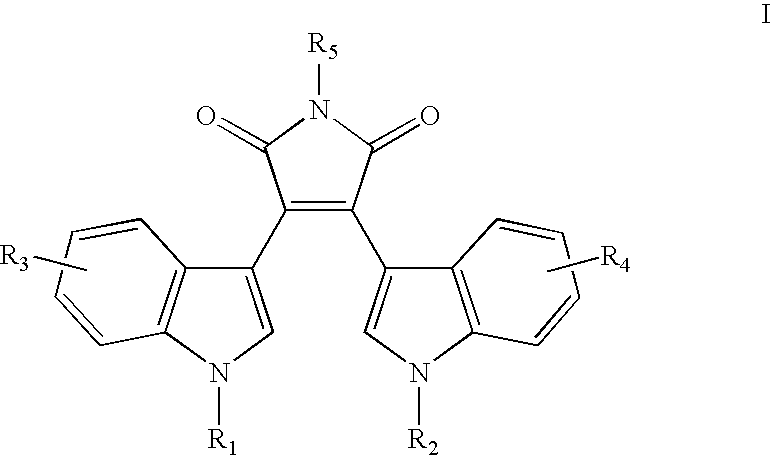Compounds for immunopotentiation
- Summary
- Abstract
- Description
- Claims
- Application Information
AI Technical Summary
Benefits of technology
Problems solved by technology
Method used
Image
Examples
examples
Preparation of Quinazolines
In the above reaction, halo is preferably chloro, bromo, or iodo. The reaction is a Grignard, carried out in an inert organic solvent, such as toluene, at a temperature between room temperature and the reflux temperature of the reaction mixture. Most significantly, the reaction is dependent on solvent conditions. When carried out in a Toluene:THF:ether solvent system, the reaction provides the product in high yield. The product is precipitated from the reaction mixture with ammonium chloride (NH4Cl). The resulting bis-3,4(3′-indolyl)-1N-pyrrole-2,5-dione product, may be isolated by standard techniques.
In the next step, L is a good leaving group such as chloro, bromo, iodo, mesyl, tosyl, and the like. L may also be a hydroxy or other precursor that may be readily converted to a good leaving group by techniques known in the art. For example, the hydroxy may be readily converted to a sulfonic ester such as mesyl by reacting the hydroxy with methanesulfonyl ch...
example 60
1-(4-Chloroanilino)-4-(4-pyridylmethyl)phthalazine dihydrochloride
A mixture of 15.22 g (59.52 mmol) 1-chloro-4-(4-pyridylmethyl)phthalazine (for preparation see German Auslegeschriftno. 1 061 788 published Jul. 23, 1959]), 7.73 g (60.59 mmol) 4-chloroaniline and 200 ml 1-butanol is heated for 2 h under reflux. The crystallizate which is obtained when the mixture slowly cools to 5° C. is then filtered off and washed with 1-butanol and ether. The filter residue is dissolved in about 200 ml hot methanol, the solution is treated with 0.75 g activated carbon and filtered Via a Hyflo Super Cel, and the pH of the filtrate is adjusted to about 2.5 with 7 ml 3N methanolic HCl. The filtrate is evaporated to about half the original volume and ether added until slight turbidity occurs; cooling then leads to the precipitation of crystals. The crystallizate is filtered off, washed with a mixture of methanol / ether (1:2) as well as ether, dried for 8 h at 110° C. under HV, and equilibrated for 72 h...
example 61
1-(4-Chloroanilino)-4-(4-pyridylmethyl)phthalazine hydrochloride
A mixture of 0.972 g (3.8 mmol) 1-chloro-4-(4-pyridylmethyl)phthalazine, 0.656 g (4 mmol) 4-chloroaniline hydrochloride (Research Organics, Inc., Cleveland, Ohio, USA) and 20 ml ethanol is heated for 2 h under reflux. The reaction mixture is cooled in an ice bath, filtered, and the crystallizate washed with a little ethanol and ether. After drying under HV for 8 h at 110° C. and for 10 h at 150° C., the title compound is obtained as a result of thermal removal of HCl; m.p. >270° C.; 1H NMR (DMSO-d 6) 9.80-11.40 (br), 8.89-8.94 (m, 1H), 8.67 (d, 2H), 8.25-8.30 (m, 1H), 8.06-8.17 (m, 2H), 7.87 (d, 2H), 7.69 (d, 2H), 7.49 (d, 2H), 4.81 (s, 2H); ESI-MS: (M+H)+=347.
PUM
| Property | Measurement | Unit |
|---|---|---|
| Molar density | aaaaa | aaaaa |
| Temperature | aaaaa | aaaaa |
| Temperature | aaaaa | aaaaa |
Abstract
Description
Claims
Application Information
 Login to View More
Login to View More - R&D
- Intellectual Property
- Life Sciences
- Materials
- Tech Scout
- Unparalleled Data Quality
- Higher Quality Content
- 60% Fewer Hallucinations
Browse by: Latest US Patents, China's latest patents, Technical Efficacy Thesaurus, Application Domain, Technology Topic, Popular Technical Reports.
© 2025 PatSnap. All rights reserved.Legal|Privacy policy|Modern Slavery Act Transparency Statement|Sitemap|About US| Contact US: help@patsnap.com



